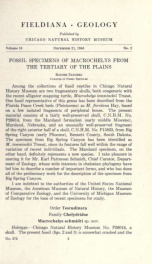Comparative microscopic dental anatomy in the Petalodontida (Chondrichthyes, Elasmobranchii) Fieldiana, Geology, new series, no. 26

The microscopic anatomy of the teeth in 9 genera and 23 species of the Paleozoic elasmobranch order Petalodontida was examined in numerous thin sections. With two exceptions, the crowns of these teeth are covered with a highly characteristic, compound tissue, which Moy-Thomas called "tubular dentine" and for which the term "orthotrabeculine" is here proposed. Orthotrabeculine consists of a hypermineralized homologue of modern shark orthodentine and peritubular trabeculine surrounding vascular channels. On the flanks of the crown of Petalodus occurs the most primitive state of this tissue; its histogenetic development is discussed. In some species of Chomatodus and in Tanaodus, orthotrabeculine also forms an internal structure that may extend all the way from the cutting edge of the crown to the vicinity of the tooth base Includes bibliographical references (p. 40-42) The microscopic anatomy of the teeth in 9 genera and 23 species of the Paleozoic elasmobranch order Petalodontida was examined in numerous thin sections. With two exceptions, the crowns of these teeth are covered with a highly characteristic, compound tissue, which Moy-Thomas called "tubular dentine" and for which the term "orthotrabeculine" is here proposed. Orthotrabeculine consists of a hypermineralized homologue of modern shark orthodentine and peritubular trabeculine surrounding vascular channels. On the flanks of the crown of Petalodus occurs the most primitive state of this tissue; its histogenetic development is discussed. In some species of Chomatodus and in Tanaodus, orthotrabeculine also forms an internal structure that may extend all the way from the cutting edge of the crown to the vicinity of the tooth base Fieldiana series has been published as Geological Series by Field Columbian Museum (1895-1909) and Field Museum of Natural History (1909-1943), and as Fieldiana: Geology by Chicago Natural History Museum (1945-1966) and Field Museum of Natural History (1966-1978). Fieldiana Geology New Series No. 1 began June 29, 1979
Info about the book
Author:
Series:
Unknown
ISBN:
1175661031
Rating:
5/5 (3)Your rating:
0/5
Languge:
English
Users who have this book
Users who want this book
What readers are saying
What do you think? Write your own comment on this book!
write a commentif you like Comparative microscopic dental anatomy in the Petalodontida (Chondrichthyes, Elasmobranchii) Fieldiana, Geology, new series, no. 26 try:
Do you want to read a book that interests you? It’s EASY!
Create an account and send a request for reading to other users on the Webpage of the book!










